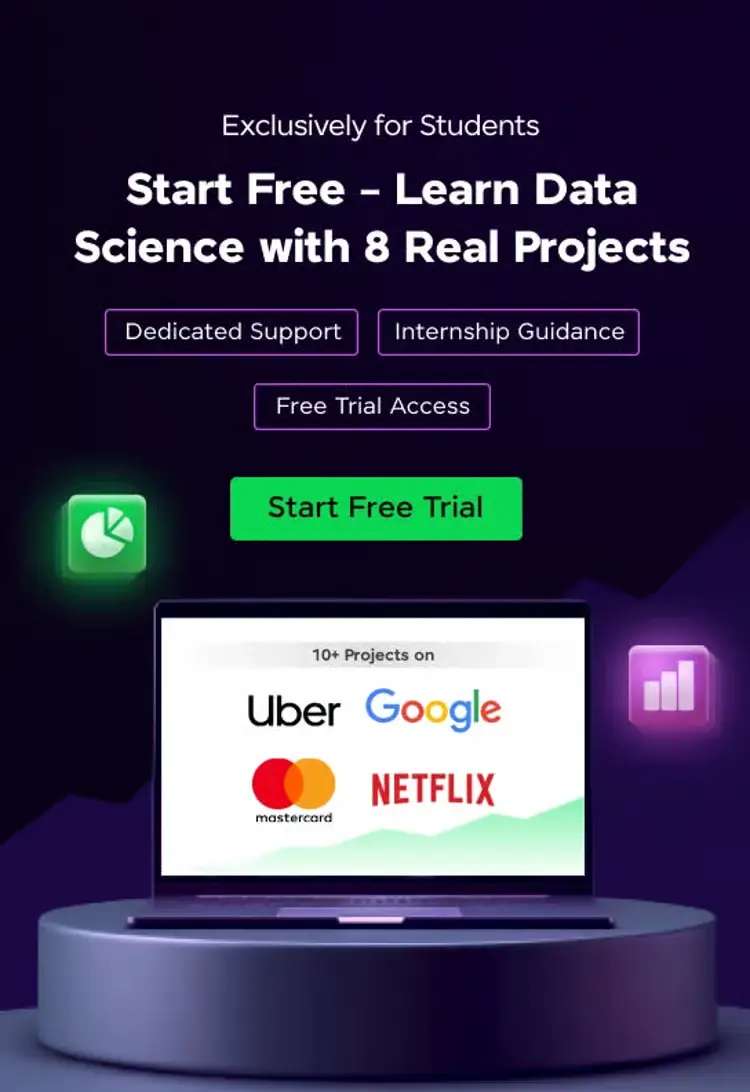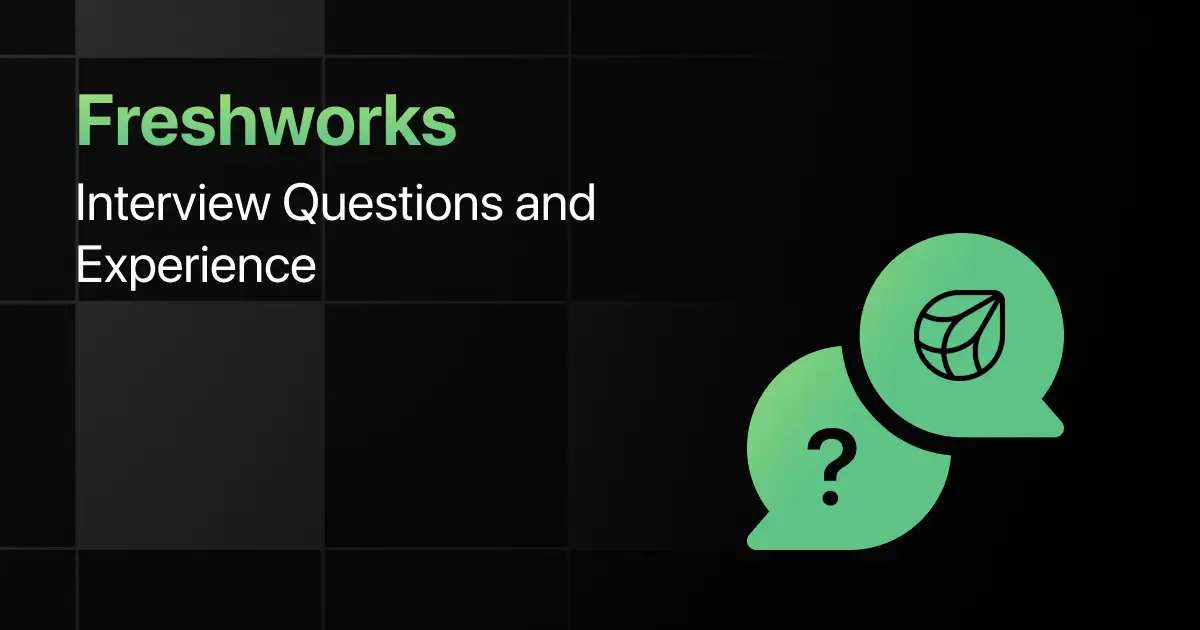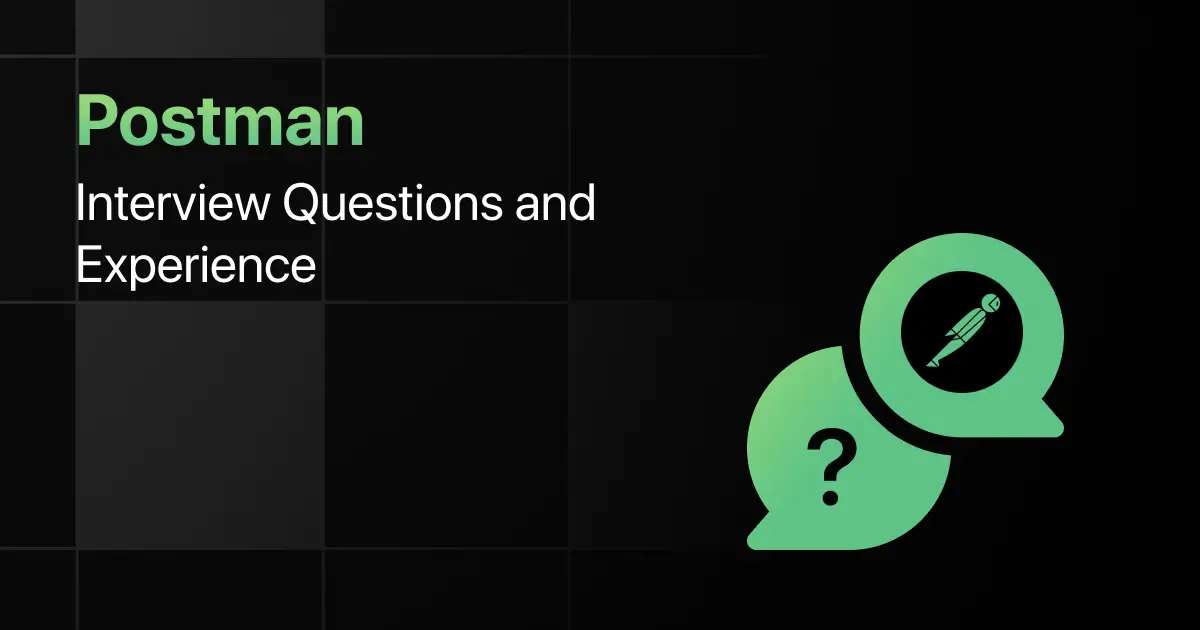Adobe Interview Questions and Experience
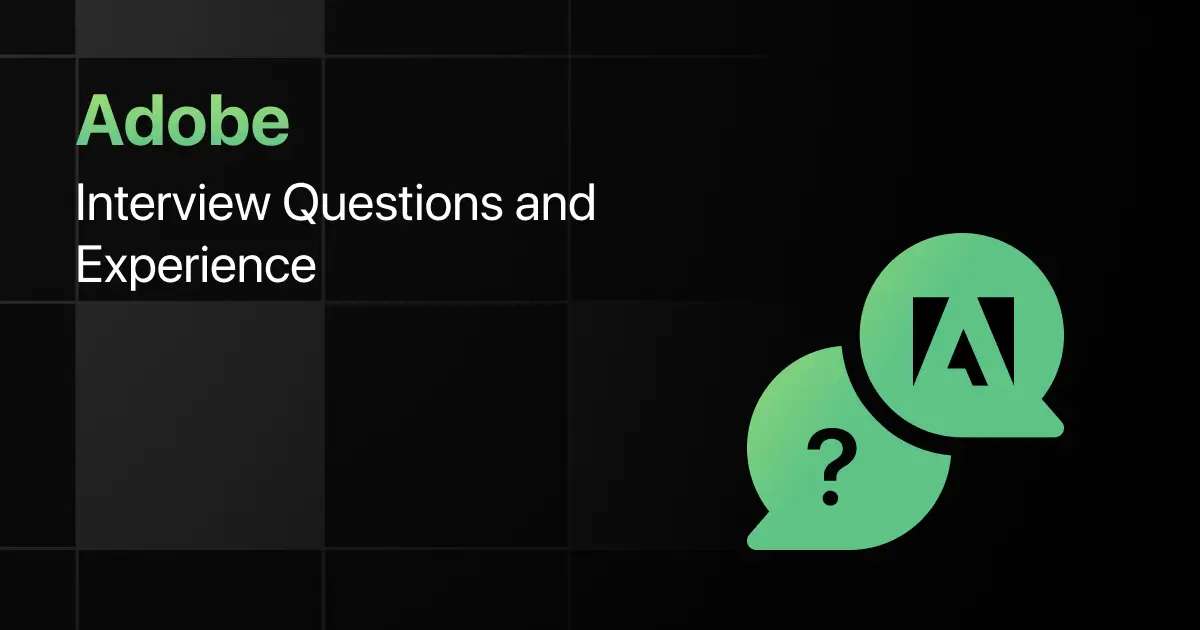
Have you ever wondered what it really takes to crack an interview at Adobe? You may be curious about the types of questions they ask or how challenging the process is.
Preparing for interviews at top companies can feel overwhelming. You need to cover coding, system design, and behavioral questions while also managing your time effectively. It is easy to feel lost without a clear plan.
In this blog, I will walk you through the Adobe interview process and share the types of questions asked. By the end, you will know exactly how to prepare with confidence.
Adobe Hiring Process – Overview
Here’s a quick overview of Adobe’s hiring process:
| Category | Details |
|---|---|
| Eligibility | Open to both freshers and experienced candidates. Preferred degrees include B.Tech, M.Tech, MCA, or related fields in Computer Science and IT. |
| Rounds | 4–5 rounds: Online Assessment, Technical Interviews (2–3 rounds), Managerial/HR Interview. |
| Job Roles Offered | Software Development Engineer, Product Intern, Quality Engineer, Data Scientist, UX Designer. |
| Salary Range | Freshers: ₹10–18 LPA (Glassdoor, AmbitionBox). Experienced: ₹25–45 LPA depending on role and experience (Glassdoor). |
| Apply Link | Apply Now |
Top Adobe Interview Questions
Preparing for an Adobe interview means sharpening both your problem-solving and technical foundations. The company is known for testing not just your coding ability but also your design skills, analytical thinking, and how you apply concepts in real scenarios.
Here are some of the most common technical questions asked in Adobe interviews
1. Technical Questions
- What is the difference between an abstract class and an interface in Java?
An abstract class can have both abstract and concrete methods, while an interface only declares methods that must be implemented by a class. - How do you detect a cycle in a directed graph?
Use Depth First Search (DFS) with a recursion stack or Kahn’s algorithm for topological sorting. - Explain the difference between stack and heap memory.
Stack is used for static memory allocation, while heap is used for dynamic memory allocation at runtime. - How would you design an LRU cache?
Use a combination of a doubly linked list and a hash map to achieve O(1) insertion, deletion, and lookup. - What are the differences between TCP and UDP?
TCP is connection-oriented and reliable, while UDP is connectionless and faster but less reliable. - How do you implement a queue using two stacks?
Use one stack for enqueue operations and the other for dequeue, transferring elements when necessary. - Explain normalization in databases. Why is it important?
Normalization organizes data into structured tables to reduce redundancy and improve consistency. - What are the different types of joins in SQL?
Inner Join, Left Join, Right Join, Full Join, and Cross Join. - What is the difference between multithreading and multiprocessing?
Multithreading runs multiple threads within a process sharing memory, while multiprocessing runs multiple independent processes with separate memory. - How do you implement binary search recursively and iteratively?
Use recursion to divide the array in halves or use a loop with low, high, and mid pointers. - What are ACID properties in databases?
Atomicity, Consistency, Isolation, and Durability ensure reliable transaction management. - How do you reverse a linked list?
Iteratively use three pointers (prev, curr, next) to reverse links, or use recursion. - What is dynamic programming? Can you give an example?
Dynamic programming breaks problems into overlapping subproblems and stores results. Example: Fibonacci sequence using memoization. - How do you handle deadlocks in operating systems?
Use techniques like resource ordering, deadlock detection, or implementing timeouts. - What is the difference between REST and SOAP APIs?
REST uses lightweight HTTP and supports JSON/XML, while SOAP is protocol-based and stricter with XML.
2. Role-Based Questions
For Freshers
- Tell me about a project you worked on during college and your role in it.
In my final year, I developed a task management web app using React and Node.js, where I was responsible for designing the front-end and integrating APIs, which improved my skills in building scalable applications. - How do you approach learning a new technology?
When I started with Python, I broke it down into basics, practiced small projects daily, and then applied it in a data visualization project, which made the learning process structured and practical. - What is the difference between Java and C++?
Java is platform-independent and handles memory automatically, whereas C++ gives more control with manual memory management; for example, in Java I used garbage collection for a project, while in C++ I manually freed memory in a simulation program. - Why do you want to join Adobe as a fresher?
I admire Adobe for products like Photoshop and Acrobat that have transformed industries, and I want to be part of a company where I can learn from top engineers while contributing to innovative solutions.
For Developers
- How do you optimize the performance of a web application?
In one of my projects, I reduced API response time by 40% by introducing Redis caching and optimizing database queries, which made the application handle higher traffic smoothly. - What is the difference between GET and POST methods in HTTP?
GET is mainly used to retrieve data, like when fetching a user profile, while POST is used to send data, such as when submitting a login form with sensitive information. - How do you ensure your code is scalable?
I write modular functions, use clean architecture, and apply efficient algorithms; for example, in a project handling large datasets, I switched from nested loops to a hash map approach, which cut execution time in half. - Can you explain your approach to debugging a production issue?
When a payment service failed in my project, I first reproduced the issue in a staging environment, checked logs for errors, identified a faulty API call, and deployed a fix within an hour to restore functionality.
For Analysts
- How do you analyze data trends to provide business insights?
In my internship, I used SQL and Tableau to analyze customer purchase data and identified that weekend sales were 25% higher, which helped the marketing team plan targeted campaigns. - What is the difference between correlation and causation?
Correlation shows a relationship, like noticing that higher ad spend correlates with higher sales, but causation means one directly drives the other, which requires controlled experiments like A/B testing. - How would you handle incomplete or inconsistent data?
When analyzing survey results with missing age values, I used median imputation to fill gaps and cross-checked responses with other demographic data to ensure accuracy. - How do you measure the success of a product feature?
For a feature I worked on, I measured adoption rate, user retention, and average time spent, and the data showed a 15% increase in engagement after the feature launch.
For Managers
- How do you handle conflicts within your team?
In my last project, two developers disagreed on a design approach, so I set up a short discussion, listened to both sides, and guided them to agree on a hybrid solution that combined speed with maintainability. - How do you prioritize tasks in a high-pressure project?
When facing a tight deadline, I list tasks by impact, assign critical bugs to senior developers, and move less urgent improvements to the backlog to keep delivery on track. - How do you ensure your team adapts to new technologies at Adobe?
When my team had to adopt a new framework, I organized weekly learning sessions, encouraged pair programming, and allocated time for experiments, which made the transition smooth.
3. Behavioral Questions
- Tell me about a time when you worked in a team to deliver a project.
During my internship, I collaborated with three teammates to build a reporting dashboard, and I focused on the backend integration while ensuring clear communication so we delivered the project two days before the deadline. - How do you handle feedback from your manager or peers?
When my mentor pointed out that my code lacked comments, I immediately revised it, added clear documentation, and since then, I make it a habit to write cleaner, more readable code. - Describe a situation where you faced a tight deadline. How did you manage it?
While preparing a client demo, I had only 24 hours to fix a major bug, so I prioritized debugging, asked for support from a senior engineer, and successfully resolved it before the presentation. - How do you handle conflicts within your team?
In a college hackathon, two teammates disagreed on the tech stack, so I facilitated a quick discussion, weighed pros and cons, and we agreed on a solution that balanced both speed and scalability. - Give an example of when you took initiative without being asked.
During my internship, I noticed repetitive manual testing slowed down deployments, so I created a small automation script that reduced the testing time by 30%. - How do you adapt to learning a new tool or process quickly?
When my team switched from Trello to Jira, I spent a weekend exploring its features, created a short guide for my teammates, and this helped the entire team adapt faster. - Tell me about a time you failed and what you learned from it.
In my first coding competition, I mismanaged my time and couldn’t finish all problems, but it taught me to prioritize easier problems first and manage my time better under pressure. - How do you make sure your work aligns with the company’s values?
I always review my tasks against the broader project goals; for example, while working on a feature, I ensured it improved user experience, which I knew aligned with Adobe’s customer-first value.
Adobe Interview Experiences
1. Member of Technical Staff Interview Experience (Fresher)
Here’s the interview journey of Gagan Gupta, who appeared for Adobe’s off-campus hiring process for the role of Member of Technical Staff (MTS).
Candidate Background:
Gagan completed his B.Tech in CSE from Chandigarh Group of Colleges, Landran. He worked at Infosys as a Specialist Programmer Intern, gaining experience in full-stack projects with MERN, Android development, and competitive programming (4-star on CodeChef).
Interview Process They Faced
- The process included 4 rounds:
- Online Test (32 questions: coding, aptitude, English, reasoning).
- Technical Interview 1 (DSA, binary tree, array operations, project discussion).
- Technical Interview 2 (C++ internals, AVL trees, polymorphism, linked list cloning).
- Technical Interview with Manager (projects, Infosys experience, system design basics, array problems).
Questions Asked
- Array operations with halving elements until ≤ k.
- Check if a binary tree is BST.
- Difference between AVL tree and Red-Black tree.
- Polymorphism implementation (compile-time vs runtime).
- Clone linked list with random pointer.
- Design a download manager.
- Questions about Infosys projects and switch motivation.
Outcome & Difficulty Level:
Gagan successfully cleared all rounds and received an offer. He described the second technical round as the hardest due to in-depth C++ grilling. His feedback emphasized honesty, thinking out loud, and preparing for 3–4 back-to-back rounds in one day.
2. Java Developer role Interview Experience (Experienced)
This is the interview experience of a candidate who cracked 7 rounds at Adobe for a Java Developer role in 2025, from Kavya.
Candidate Background:
An experienced Java developer with strong expertise in Core Java, Spring Boot, microservices, multithreading, and system design. The candidate also had prior project experience in backend development and large-scale distributed systems.
Interview Process They Faced
- The process spanned 7 rounds:
- Online Assessment (Hackerrank – coding + MCQs).
- Core Java + Data Structures round.
- Spring Boot and Microservices technical round.
- Low-Level System Design (Rate Limiter, URL Shortener).
- Multithreading & Concurrency challenges.
- Hiring Manager round (project, production issues, leadership).
- HR round (culture, values, compensation).
Questions Asked
- Longest Consecutive Subsequence (DSA).
- Kth Largest Element in a Stream.
- HashMap contract with hashCode() and equals().
- LRU Cache implementation.
- Spring Dependency Injection, @Component vs @Service vs @Repository.
- Design a Rate Limiter and scalable URL shortener.
- Producer-Consumer problem and synchronization concepts.
- Handling production failures, conflict resolution, project ownership.
- HR questions on notice period, values, and preferences.
Outcome & Difficulty Level:
The candidate cleared the process and received an offer. She described the interviews as extremely challenging, especially system design and concurrency rounds. Key takeaways included preparing deeply for Java internals, practicing real-world system design, and knowing Adobe’s cultural values.
Preparation Tips for Adobe Interviews
Preparing for an Adobe interview requires balancing technical excellence with strong communication and problem-solving skills. Here are some focused tips to help you succeed:
- Know the Basics: Review core subjects like data structures, algorithms, OOP concepts, databases, and operating systems. Adobe often tests your fundamentals in both coding and problem-solving.
- Practice Coding: Solve coding questions daily on platforms like LeetCode, HackerRank, or GFG. Focus on medium-to-hard level problems since Adobe values clear logic and optimal solutions.
- Understand Projects: Be ready to explain your academic or personal projects in depth. Highlight your role, challenges faced, and the results you achieved to show both technical and ownership skills.
- Learn Adobe Tools: Familiarize yourself with Adobe’s key products like Adobe Experience Cloud, Acrobat, or Photoshop, as knowledge of the ecosystem gives you an edge.
- Behavioral Prep: Prepare examples from past experiences using the STAR method (Situation, Task, Action, Result). This helps you answer teamwork, leadership, or adaptability questions smoothly.
- Mock Interviews: Take mock interviews with peers or online platforms. This helps simulate pressure, refine your explanations, and improve confidence.
Final Words
Getting placed at Adobe can feel challenging, but with the right preparation and mindset, it is absolutely achievable. Focus on your core skills, communicate your ideas clearly, and showcase your ability to learn and adapt.
Explore More for
- Amazon
- Salesforce
- Oracle
- Microsoft
- IBM
- Flipkart
- Apple
- Uber
- Meesho
- Zomato
- Swiggy
- Phonepe
- Zoho
- Postman
- Freshworks
- Paytm
- Darwinbox
FAQs
Adobe commonly asks about data structures, algorithms, OOP concepts, system design, and scenario-based problem-solving, along with project and behavioral questions.
For freshers, Adobe interviews are moderately tough as they emphasize problem-solving, coding efficiency, and fundamentals rather than advanced real-world experience.
The complete Adobe interview process usually spans two to three weeks, including online assessments, multiple technical rounds, and an HR or behavioral round.
Candidates should focus on coding in Java, C++, or Python, database management, operating systems, OOP concepts, and analytical problem-solving skills.
Candidates often fail by not explaining their thought process, ignoring edge cases in coding, lacking project clarity, or skipping questions about Adobe products.
The Adobe interview process generally has four to five rounds, including online assessments, technical interviews, a managerial round, and an HR discussion.
Yes, freshers face fundamental and coding questions, while experienced candidates are tested on system design, scalability, leadership, and domain-specific problem-solving.
The best way is to practice coding daily, revise fundamentals, work on projects, and use resources like Placementpreparation.io for structured guidance.
Related Posts
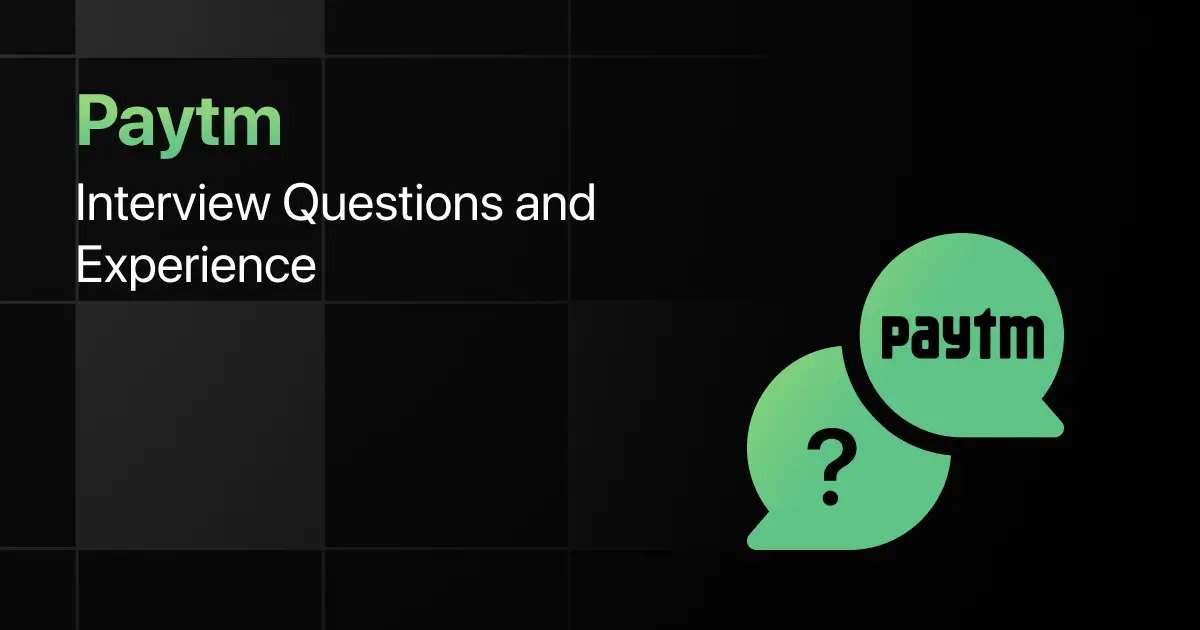

Paytm Interview Questions and Experience
Preparing for a Paytm interview requires a clear understanding of the company’s hiring process, the type of questions asked, and …
Warning: Undefined variable $post_id in /var/www/wordpress/wp-content/themes/placementpreparation/template-parts/popup-zenlite.php on line 1050


